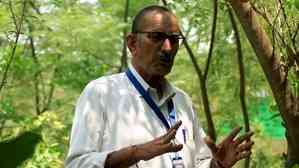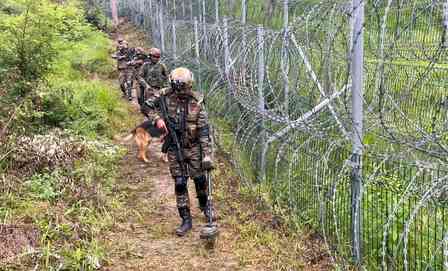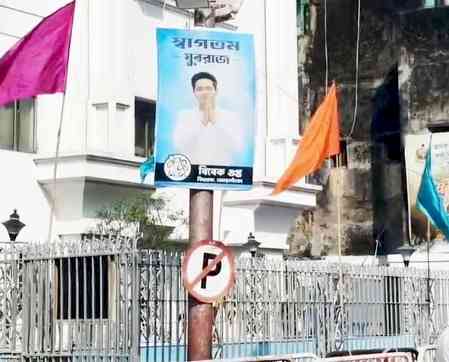Once famous as the desert state, Rajasthan now battles excess rain, floods
As the world eagerly awaits the COP28 climate negotiations, the small but significant initiatives taken by the ‘Treeman’ and the ‘Waterman’ of Rajasthan are worth discussing here as they have brought phenomenal changes in a desert state at a time when climate change and its effect are clearly evident.

Archana Sharma
Jaipur, Nov 19 (IANS) As the world eagerly awaits the COP28 climate negotiations, the small but significant initiatives taken by the ‘Treeman’ and the ‘Waterman’ of Rajasthan are worth discussing here as they have brought phenomenal changes in a desert state at a time when climate change and its effect are clearly evident.
Himmat Ram Bhambhu, also known as ‘Treeman’, was awarded the Padma Shri in 2021 by the President for his social and environmental work.
Bhambhu is a farmer and environmentalist, who works selflessly for the protection of nature. He has planted around 5.5 lakh saplings throughout Rajasthan of which 3.5 lakh have grown into trees, generating oxygen worth Rs 12 billion for the people.
Bhambhu, who hails from Nagaur district in Rajasthan takes pride in his work and urges people to start caring for the environment, else they will face the consequences of not caring for the planet by the year 2040.
"The rising temperatures across the world due to global warming are a warning sign for all. Every person might have to carry oxygen 24x7 if the current trend of depletion of the green cover continues," he told IANS.
Bhambhu has converted his six-hectare piece of land into a jungle by planting 11,000 trees. Now there are 300 peacocks and hundreds of deer and other animals on this land.
"Even the peepal tree which my grandmother inspired me to grow has spread wide and large, allowing around 500 people to sit under it. We celebrate its birthday each year by lighting diyas around it," he said.
Bhambhu is 71 now, but there is no lack of energy in him and he aims to plant 2 lakh more trees.
"While a person normally lives till 80, a peepal tree can live for 700 years while many other trees also live for around hundreds of years. So, we all should try to grow one sapling into a tree," he said, adding, "We have ensured that we plant one tree on the birth of each child in our village and name it after the baby so that his/her name lives on for hundreds of years."
Bhambhu also has issues with bursting crackers during Divali. "When we were kids, we used firecrackers in limited numbers. But over the years, factories producing crackers have mushroomed with the sky turning into a smoke chamber during Diwali, posing health hazards to people, especially the children and the elderly. Is this the way to celebrate festivals," he asked.
"I have made 2.5 lakh children take a pledge to shun crackers during Diwali. Instead, they can light diyas and distribute clothes and sweets to the poor by saving the money they spend on crackers," he added.
While the work of this ‘Treeman’ is garnering accolades across the state, the ‘Waterman’ Rajendra Singh from Alwar has also made significant contributions. He understands the impending water crisis.
Popularly known as the ‘Waterman of India’, Singh has dedicated his life to the conservation of water bodies. Born in Meerut, Uttar Pradesh, Singh, and is a trained Ayurvedic medicine practitioner who started his career with the Education Department in Jaipur, Rajasthan
In Jaipur, he also started working with Tarun Bharat Sangh (TBS), an NGO formed by officers and students of the university.
During his work with TBS, Singh got to learn about the struggles of the people of rural Rajasthan, and in 1984 decided to leave his government job to work for the betterment of their lives.
One of his first learnings was how borewells were adversely impacting the water cycle. As people started depending more and more on borewells to irrigate their land instead of the traditional johad, which were used to harvest rainwater and subsequently recharge the water table, the groundwater levels dropped.
Singh's message of water conservation using traditional techniques has since spread beyond Alwar and Rajasthan to across the world.
The ‘Waterman of India’ has been recognised globally for his work with honours including the 2001 Ramon Magsaysay Award For Community Leadership and the 2015 Stockholm Water Prize, known as "the Nobel Prize for water" to name a few.
Besides these two activists there are many heroes who are transforming lives of millions by weaving the stories of sustainability and nature protection.
Piplantri sarpanch is yet another figure who turned a barren area into a forest with 3 lakh trees. Shyam Sundar Paliwal pledged to plant 111 trees for every girl child born in Piplantri Village in Rajasthan. Today his promise has turned into an entire forest.
While such heroes continue working for nature, climate change and its effects are clearly visible in Rajasthan, causing worries for many. The rainfall has increased more than the average in the last few years. The pre-monsoon rains this year was 312 per cent more than the average season from March-May this year.
Once infamous for its dry weather, the desert state now receives erratic rainfall, which has even led to flooding a few times.
This year, the state saw 95.5 mm of rain from March 1, 2023 to May 31, 2023 while in general there is about 4.8 per cent of annual rainfall recorded in the pre-monsoon season in Rajasthan.
Surprisingly, May rainfall smashed a 105-year-old record, as it rained 62.4 mm in the entire month which is 458 per cent more than usual.
Also, the desert areas in the western part of the state have started receiving maximum rainfall in the once arid zones.
West Rajasthan in fact received more rain than east Rajasthan this year. It needs to be mentioned here that most of western Rajasthan is a desert with a long history of drought.
As per the state weather department, all 33 districts of the state received much more rain than usual, that is, more than 60 per cent rainfall. Bikaner city in fact broke all old records with 72.8 mm of rainfall on May 29, 2023.
In 2017, the state suffered heavy losses due to floods after heavy rains, as the people of Rajasthan know how to deal with droughts but are unprepared for flooding. Even the state’s disaster management plan did not include floods.
Incidences of flooding in the state have only increased since then. There was excess rainfall of 141 per cent in the monsoon of 2019. In the monsoon season of 2021, Rajasthan received 117 per cent excess rainfall. September 2021 witnessed 176 per cent excess rainfall than average.
Congress MLA Bharat Singh expressed concern on the changing landscape in the state and said, “There are many hills which have gone missing in the state. In fact, on the other hand, hills have been created on the plains by the locals by dumping garbage.”
Speaking to IANS, Singh said, “We recently saw cracks wreaking havoc in Joshimath in Uttarakhand. This story can be repeated in Rajasthan too. It is sad that governments realise the gravity of the issue when the situation goes out of control. The illegal mining in the state has thrown many challenges, however, everyone seems to be sitting with folded hands. They will wake up from their slumber when disaster strikes.”
“The entire ecology has changed in the region. The sad part is that such facts are being reviewed under an economic lens, keeping monetary prospects in mind and hence everyone has joined hands in this illegal act… Unitedly, they are exploiting the hills till they disappear”, he added.


 IANS
IANS 










